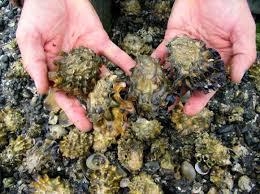The Working Waterfont, May 21, 2014. By Heather Deese and Susie Arnold
A recent study led by Aleck Wang, a chemical oceanographer from Woods Hole Oceanographic Institution, has identified the Gulf of Maine as outstanding in an unfortunate way—more susceptible to pressures of ocean acidification than any other region along the eastern seaboard and Gulf of Mexico.
 Ocean acidification may not be a familiar term for many, but it is a critically important aspect of ocean chemistry for all of us to understand.
Ocean acidification may not be a familiar term for many, but it is a critically important aspect of ocean chemistry for all of us to understand.
Ocean acidification is the changing chemistry of seawater caused by the ocean’s absorption of carbon dioxide (CO2). As CO2 is absorbed into seawater, the resulting reactions decrease the availability of carbonate ions, which are critical building blocks for forming the shells and skeletons of many marine organisms. The process also increases the number of hydrogen ions, which leads to lower pH and greater acidity. Toxic chemicals from storm water, industrial pollution and other runoff that flows into the ocean also can contribute to acidification of coastal waters.
Wang and his colleagues think the Gulf of Maine’s susceptibility may be due to a few different factors. Fresh and cold water holds more CO2, and the Gulf of Maine has a lot of colder and fresher water coming in from the Labrador Current, in addition to a large proportion of fresh water from rivers. Also, the semi-enclosed shape of the Gulf tends to hold this more acidic water.
Around the same time this study came out, researchers in Alaska published disturbing results on the impacts of ocean acidification on Red King Crab and Tanner crabs. Their laboratory studies showed decreased survival and growth in low pH water in both species and 100 percent mortality of Red King Crab larvae after 95 days in acidification scenarios predicted for the end of this century.
A few months later, a scallop aquaculture operation in British Colombia appeared to become the latest commercial victim of ocean acidification with a massive die-off.
Oyster aquaculturists on the West Coast have been responding to die-offs for nearly ten years and within the last several years their onsite pH monitoring has confirmed the link to acidification. Upwelling conditions in the Pacific Northwest, which bring cold water to the surface, tend to have lower pH than surface water. The pH of this water has decreased further in recent decades due to increasing atmospheric CO2 and pollutants that run from the land into the ocean.
Rep. Mick Devin, D-Newcastle, who also is a marine biologist at the University of Maine’s Darling Marine Center, has been concerned about the vulnerability of Maine’s marine ecosystems and fisheries-dependent communities to this unfolding threat. Last fall, he proposed LD 1602, which would establish a commission to study the effects of coastal and ocean acidification on species that are commercially harvested and grown along the Maine coast.
Thanks to support from diverse interest groups, including fishing and aquaculture industries, coastal community members, environmental groups, state agencies and others, the bill became law April 30.
Scientists still don’t know exactly how changing chemistry will impact the various life stages of most marine organisms, particularly a lot of commercially important species. For example, there is still very little known about the possible impacts on lobsters.
Read more here
